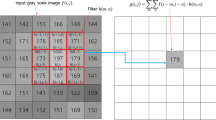Abstract
Thin Film Transistor—Liquid Crystal Displays (TFT-LCDs) are widely used in TVs, monitors, and PDAs. The key process of producing a TFT-LCD is using alignment to combine a Thin Film Transistor (TFT) panel with a Color Filter (CF) panel, which is called “celling”. The defined cell vernier, which indicates the alignment error, is an important quality index in the manufacturing process. In the CF manufacturing process, the cell vernier is difficult to control because it depends on six TPEs (Total Pitch Errors), with each TPE highly dependent on the others. This paper aims to improve the cell vernier forecasting model with the six TPE attributes to enhance the production yield in the CF manufacturing process. Using the six dependent variables, this study found that the SVR (Support Vector Machine for Regression) model is the fittest for generating quality results that meet the designed specifications.
Similar content being viewed by others
References
Amari S., Wu S. (1999) Improving support vector machine classifiers by modifying kernel functions. Neural Networks 12: 783–789
Chang, K.-H., Cheng, C.-H. (2009). Evaluating the risk of failure using the fuzzy OWA and DEMATEL method. Journal of Intelligent Manufacturing, Published online.
Chang P.-C., Chen L.-Y., Liu C. H. (2006) An evolutionary regulation algorithm for the twin laser measuring system. Journal of Intelligent Manufacturing 17(5): 545–556
Chen S.-H., Chang C.-K., Kuo C.-L. (2005) Optimal scheduling in color filter manufacturing. Journal of the Chinese Institute of Industrial Engineers 22(4): 301–308
Cortes C., Vapnik V. N. (1995) Support vector networks. Machine Learning 20: 273–297
Eicker F., Ewald G. (2004) Linearly independent set families. Linear algebra and its applications 388(1): 173–191
Hair J.F. Jr., Ralph E.A., Ronald L.T., William C.B. (1998) Multivariable data analysis 5th. Prentice Hall, Upper Saddle River, NJ
Haykin S. (1999) Neural Networks—a comprehensive foundation. Prentice Hall, Upper Saddle River, NJ
Hocking R.R. (1976) A biometrics invited paper: The analysis and selection of variables in linear regression. Biometrics 32: 1–49
Huang C.F., Moraga C. (2004) A diffusion-neural-network for learning from small samples. International Journal of Approximate Reasoning 35: 137–161
Li D.C., Lin Y.S. (2006) Using virtual sample generation to build up management knowledge in the early manufacturing stages. European Journal of Operational Research 175: 413–434
Li D.C., Wu C.S., Chang F.M. (2006) Using data continualization and expansion to improve small data set learning accuracy for early flexible manufacturing system (FMS) scheduling. International Journal of Production Research 44(21): 4491–4509
Li D.C., Chen L.-S., Lin Y.-S. (2003) Using functional virtual population as assistance to learn scheduling knowledge in dynamic manufacturing environments. International Journal of Production Research 41(17): 4011–4021
Niyogi, P., Girosi, F., & Tomaso, P. (1998). Incorporating prior information in machine learning by creating virtual examples. In: Proceedings of the IEEE (pp. 275–298).
Sánchez A.V.D. (2003) Advanced support vector machines and kernel methods. Neurocomputing 55: 5–20
Shawkat A., Kate A., Smith M. (2006) A meta-learning approach to automatic kernel selection for support vector machines. Neurocomputing 70: 173–186
Smola A.J., Scholkoph B. (2004) A tutorial on support vector regression. Statistic Computing 14(3): 199–222
Tan P.-N., Steinbach M., Kumar V. (2006) Introduction to data mining. Pearson Press, New York
Witten I.H., Frank E. (2005) Data mining: Practical machine learning tools and techniques 2nd. Morgan Kaufmann, San Francisco
Author information
Authors and Affiliations
Corresponding author
Rights and permissions
About this article
Cite this article
Li, DC., Chen, WC., Liu, CW. et al. A non-linear quality improvement model using SVR for manufacturing TFT-LCDs. J Intell Manuf 23, 835–844 (2012). https://doi.org/10.1007/s10845-010-0440-1
Received:
Accepted:
Published:
Issue Date:
DOI: https://doi.org/10.1007/s10845-010-0440-1




